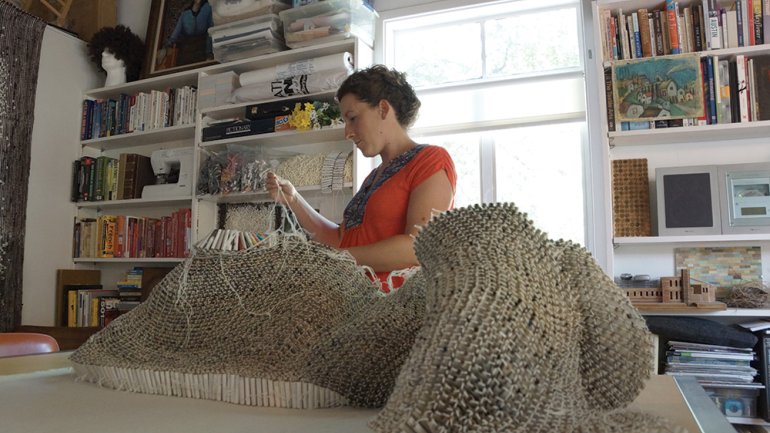Impractically Perfect
Impractically Perfect
“If a material intrigues me, I go with it,” says Briana Babani. Recently the material has been paper, painstakingly threaded into 2-by-2-foot sections she has woven of wool-and-paper weft and linen warp, then hand-stitched to create a contoured landscape of texture. Tough, inflexible, and heavy, paper isn’t very practical for weaving, but that doesn’t stop her.
Speaking from her studio in Austin, Texas, Babani mentions a documentary on Charles and Ray Eames that she saw recently. “[They] worked in all different scales and materials, and the work is playful, wondrous.”
The same could be said of Babani, 36, and her work. Trained as a painter at Yale, she defied the expectations of her advisor by making her senior thesis project of hundreds of rolled strips of transparent packing tape. She formed them into a honeycomb structure that was suspended from the ceiling, appearing to drip to the floor. Looking back, she sees hints of the work to come. Yale didn’t have a textile department, but she was already pursuing textural interests.
Babani grew up in Lawrence, Kansas, where her mother pursued graduate studies in textile art and her father was an elementary school art teacher. Despite her obvious talent, her parents cautioned her against the vagaries of a fine art career, pressing her to do something “practical.” She was admitted to Yale on the strength of her portfolio, as well as her academic record and performance as a competitive swimmer.
It was a life-changing opportunity. “I loved it,” she says, recalling Robert Reed, a notoriously demanding drawing professor who required 100 sketches the first weekend. While she originally intended to become a graphic designer, she graduated in 1999 with a focus on painting.
She landed a position with an Italian interior designer working in New York, who specialized in hand-printed fabrics and silk painting. Babani’s job was the grunt work (“I spent hours cutting stencils”), but she remains influenced by the dedication to craft she experienced there. After nine months she found a more lucrative administrative job with a French textile company. She was in New York for nearly four years, happy to be earning a living in such a creative hub, but gradually growing restless working in an office rather than a studio.
She had already begun to experiment with silk scraps discarded by the Italian designer. Seeing possibilities, she began dyeing her own silk to make patchwork compositions and turning those into pillows. “I saw them as paintings,” she recalls; no two were the same. A book on marketing craft suggested sending a brochure to potential clients, so she did. ABC Carpet and Home responded, and the pillows sold – almost too well. “I realized I didn’t want to become known as ‘the pillow lady.’ ”
Still seeking a practical way to use her artistic talents, Babani enrolled in Rhode Island School of Design’s graduate program in interior architecture, which focuses on repurposing existing buildings. RISD’s rich offerings in glass, furniture making, industrial design, and weaving opened up new vistas for her. “I started to get more ideas and see how I could push them in different directions.”
When she completed her degree in 2006, she relocated to Austin, where she had no trouble finding work as an architect. Unfortunately, it still wasn’t creatively fulfilling. “It was awful. I worked in AutoCAD all day. It drained the life out of me.”
She returned to art and hasn’t looked back since, exploring the nuances of repetition, color, line, and gesture. Babani’s work has been sold at Barneys New York, and featured in Austin’s Tribeza Magazine Makers issue and, most recently, in Austin Home magazine. Her newest project? It’s a swag light fixture featuring a framework of tiny rolls of near-white magazine paper.
(Just don’t mention that it’s practical.)
Rachel Schalet Crabb is a fiber artist and writer in Minneapolis.

